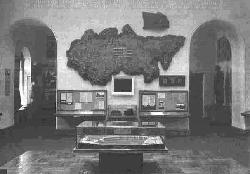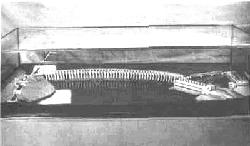The Victory of Socialism in the USSR (1925-1941)
V.I.Lenin: A socialist Soviet Republic in Russia will stand as a living example to the peoples of all countries, and the propaganda and the revolutionising effect of this example will be immense.
The documents, photographs, models and replicas presented in this hall recount the construction of socialism in the USSR. On the central wall are the words from the Programme of the Communist Party of the Soviet Union (CPSU) adopted at the 22nd Congress in October 1961: "Socialism, which Marx and Engels scientifically predicted as inevitable and the plan for the construction of which was mapped out by Lenin, has become a reality in the Soviet Union." Quotations from the works of K. Marx and V. I. Lenin on the role of the dictatorship of the proletariat in the construction of socialism are seen beneath on the display stand. Presented here is the part of the Programme adopted at the Eighth Congress of the Russian Communist Party (Bolsheviks), on the economic tasks, and that part of the CPSU Programme in which the basic elements of Lenin's plan for the building of socialism are stated. V. I. Lenin's works which reveal this historic plan are on exhibit in the display cases: "The State and Revolution", "The Immediate Tasks of the Soviet Government", "Economics and Politics in the Era of the Dictatorship of the Proletariat", "Better Fewer, But Better", "On Co-operation" and others. The exposition in this hall consists of four sections. The first is a documentary story of the realisation of Lenin's plan of the industrialisation of the USSR. The decisions of Party congresses and government decrees, awards instituted in the 1930s and early 1940s for special achievements in labour—the Order of the Red Banner of Labour, the Order of Lenin, the "Badge of Honour", the medal "For Valour In Labour", the gold star "Hammer and Sickle", are among the exhibit items in this section, as well as a replica of the V. I. Lenin Dnieper Hydroelectric Power Station, one of the first hydroelectric stations in the country; and models of the first Soviet tractors. Photographs reflecting the mass labour enthusiasm of the Soviet people during the time of the first pre-war five-year-plan periods are exhibited. The basic enterprises built in the USSR from 1928 to 1941 are shown on the map-diagram. The second section of the exposition is devoted to the programme of the socialist reconstruction of agriculture which was drawn up by V. I. Lenin and realised by the Party and the Soviet people. This was a vastly complicated task-there were more than 20 million small peasant farms in Russia before the October Revolution. Without a radical turn of these vast, to a great extent backward, masses to collectivisation the realisation of the plan for the building of socialism would have been impossible. Lenin's works, his primary version of the article "The Immediate Tasks of the Soviet Government", "Draft Programme of the RCP(B) Programme", "Report on Work in the Countryside, March 23", at the Eighth Congress of the Russian Communist Party (Bolsheviks), "The Tax in Kind", "Co-operation" and others are presented precisely in this part of the exposition, because it was in them that V. I. Lenin defined the path for the transition of the peasants to socialism, and drew up the basic principles and forms of co-operation. And there is the resolution of the 15th Party Congress, "On the Work in the Countryside". The 15th Congress went down in history as the Congress of collectivisation. An entire collection of other Party documents devoted to the problems of the socialist transformation of the countryside are also on display. Many of the exhibit items relate the tremendous aid rendered by the working class to the toiling peasantry. V. I. Lenin dreamed of 100 thousand tractors for the countryside. The diagrams show that already in 1932, 148 thousand tractors were manufactured for agriculture, and in 1940, agriculture received 684 thousand tractors. The documentary photographs attract special attention: the first tractor in the village Larino (Smolensk Gubernia), sowing at the co-operative farm "Giant" (Northern Caucasus), tractors in the shop of the Krasny Putilovets plant (Leningrad), joining a collective farm (Borisogleb region. Central Russia), and the presentation of the government act for perpetual use of the land to the collective farm workers at the collective farm "Sotsialdy" (Kazakh Soviet Socialist Republic). The third section of the exposition tells of the gigantic transformations in culture in the USSR. The following words of V.I.Lenin are presented: "We shall be unable to solve this problem unless we clearly realise that only a precise knowledge and transformation of the culture created by the entire development of mankind will enable us to create a proletarian culture." Diagrams, tables and photographs tell of the elimination of illiteracy in the country and the growth of public education, and the genuine cultural revolution which was realised throughout the entire country, including the former outlying districts of Russia, Central Asia, the North and the distant corners of Siberia. The victory of socialism in the USSR was of world-wide historical significance-such is the theme of the fourth section of the exposition in this hall. On the display stands are the documents on the achievements of Lenin's national policy, on the great industrial and cultural construction in the national republics, on Lithuania's, Latvia's and Estonia's entrance into the USSR, and on the formation of the Moldavian Soviet Socialist Republic. The Constitution of the USSR, adopted in 1936, and which legislative consolidated the victory of socialism in the Soviet Union, is displayed in this exposition. The exposition concludes with Lenin's words: "A socialist Soviet Republic in Russia will stand as a living example to the peoples of all countries, and the propaganda and the revolutionising effect of this example will be immense."
|


